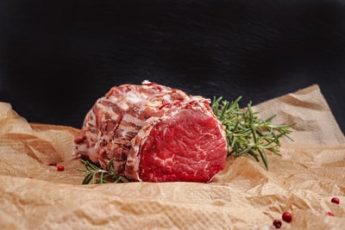
To ensure the temperature of your turkey is consistent, you can use a meat thermometer. It is usually best to insert the probe in the thickest part of the bird, about 0.5 inches to 1 inch deep. Be sure not to put the probe near bones or cartilage, as it can cause the turkey to overcook. You can also place it horizontally from the neck cavity. To ensure that the meat thermometer is properly inserted, it should be wiped clean after use with sanitizer.
The probe should be placed parallel to the body of the turkey, so that it does not hit any bones or other solid objects. A thigh thermometer should be inserted in the thickest part of the drumstick, which sticks out from the body of the turkey. It should feel resistance as it goes into the meat. You may need to use two thermometers to ensure the turkey is thoroughly cooked.
| Image | Price | Buy | Prime | Title |
|---|---|---|---|---|
Top Top
Top | Buy Now | PrimeEligible | MEATER SE: Smart Bluetooth Meat Thermometer | Long Wireless Range | for Oven, Grill, Kitchen, BBQ, Smoker, Air Fryer | Step-by-Step Recipes in App | Dual Sensors | Black Charger [2024 Release] | |
 Top
Top | Buy Now | PrimeEligible | MEATER Pro: Smart Bluetooth Wireless Meat Thermometer Digital | 1000°F Heat Resistance | Long Range | Certified Accuracy | BBQ, Oven, Grill, Smoker, Air Fryer, Deep Fryer | 50+ Recipes in App | |
 Top
Top | Buy Now | PrimeEligible | MEATER Block: WiFi Smart Wireless Meat Thermometer | 4 Probes, Long Range | Perfect for BBQ, Oven, Grill, Kitchen, Smoker, Air Fryer | Apple Watch, Alexa Compatible | iOS & Android App | |
 Top
Top | Buy Now | PrimeEligible | Wireless Meat Thermometer Digital: Smart Multi Sensors Accuracy Bluetooth WiFi Food Thermometer with Ultra-Thin Probes for Cooking, BBQ,Oven, Grill, Smoker, Heat Resistance| Long Range| Fast Charging | |
 Top
Top | Buy Now | PrimeEligible | MEATER | The Original True Wireless Smart Meat Thermometer for the Oven Grill Kitchen BBQ Smoker Rotisserie with Bluetooth and WiFi Digital Connectivity | |
 Top
Top | Buy Now | PrimeEligible | ThermoPro TempSpike Plus 600FT Wireless Meat Thermometer with Upgraded Ultra-Thin Probe, Bluetooth Meat Thermometer Wireless for Outside Grill, Smoker Thermometer for BBQ Oven Rotisserie Sous Vide |
As an Amazon Associate we earn from qualifying purchases.
A thermometer should be inserted into the meat where the body meets the thigh. This avoids the risk of cutting off any portion of the meat and compromising the quality of the cooking. The probe should be placed in the thickest part of the thigh, as it contains a large amount of muscle. Make sure that the probe does not touch any bone. You should also check the temperature of the turkey by placing a piece of foil on the thigh or in the leg cavity.
When cooking a turkey, it is important to remember that the breasts and thighs cook at different rates. The thigh and the breasts should reach 165 degrees before the thigh is ready. Be sure to cover these parts with foil if the breasts reach the desired temperature before the thighs are done. The innermost part of the thigh should measure 165 degrees. If you are not sure of the exact temperature, read the manual or consult a professional.
The meat thermometer has two parts. The tip of the thermometer is the part of the turkey that is most likely to be cold during the cooking process. The thickest part of the thigh is the thermal center. Dark meat takes longer to cook than the rest of the turkey. As a general rule, the breast is the best place to put the meat thermometer. The thigh is where you should position it in the thigh.
While most meat thermometers are oven-safe, they do not give accurate readings. The most accurate one is a digital one. It will give you a temperature at the tip of the probe while the glass dial analog type will give you an average reading across the entire meat. If you are using an analog meat thermometer, you should be careful to keep an eye on the breast temperature during the roasting process.
When using a meat thermometer, be sure to place it in the thickest part of the turkey. You should also place it near the bone, since bones are different from meat. If the probe reaches the bone, it will give you an inaccurate reading. Moreover, it will be more difficult to carve the turkey after it has rested. Regardless of the type of thermometer, it is important to place the meat thermometer in the thickest part of the breast.
If you’re using an instant read thermometer, you must turn the turkey on its side. This will help you position the thermometer in the thickest part of the turkey. Then, you must turn the turkey on its side and take the temperature. If you’re using a dial gauge thermometer, you should insert it in the thigh joint. Once the tip reaches 165 degrees, the turkey is cooked. The temperature of the drumsticks should be 165 degrees or higher.
While a meat thermometer is essential for cooking a turkey, it’s not an indispensable tool. In fact, it’s a necessary component of every turkey. The internal temperature of a turkey should be at least 165 degrees Fahrenheit. This temperature should be a minimum of 165 degrees. A few other important measurements that you should take note of include the temperature of the leg and the thigh.












